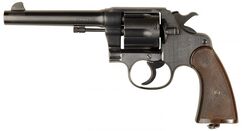
A Colt M1917 Revolver.

Soldiers training with M1917 revolvers.
The M1917 Revolver (formally United States Revolver, Caliber .45, M1917) was a revolver that was used by the United States during World War II.
Description[]

Side view of a Colt M1917 revolver.
It had a six round capacity, and fired the .45 ACP Cartridge held in a swing-out cylinder. The butt of the gun features a lanyard ring.[1]
Design[]
The frame was solid (meaning an integrated "bridge" was fitted over the cylinder for a more durable design) with a smooth barrel protruding forwards and marked with a forward blade sight just aft of the muzzle. The barrel measured a standard length of 5.5 inches while the revolver exhibited an overall length of 10.8 inches. A rear notch sight was also included in the design. The trigger ring was integrated into the receiver itself and managed a curved, double-action trigger assembly. This "doubleaction" terminology meant that no manually-actuated cocking of the hammer was required on the part of the operator - he need only pull the trigger and the hammer cocked automatically (though it could still be managed manually if so desired). The pistol grip was well-contoured downwards for a firm hand hold and covered over in wooden detail. The exposed hammer spur protruded from the rear of the receiver which allowed for manual cocking if required. An ejector rod was fitted under the barrel ahead of the frame and this was furthermore connected to the cylinder. The cylinder was fluted along its surface and bored to accepted six cartridges of .45 ACP or .45 Auto Rim ammunition, rotating smoothly in its stout frame. For reloading, the cylinder was designed to "swing out" for easy access to each of the available cartridge chambers. Overall weight was 2.5 lbs while muzzle velocity was rated at 760 feet per second.[2]
History[]
The M1917 Revolver was adopted by the U.S. Army in 1917 to supplement the standard Colt M1911 .45 ACP semi-automatic pistol during World War I. Afterwards, it was primarily used by secondary and non-deployed troops.
The United States Army had already adopted the semi-automatic, repeating Colt M1911 pistol designed by John Browning but needed to shore up war-time limitations even when various manufacturers had already committed to production of the M1911. The US Army, therefore, chartered both the Colt and Smith & Wesson concerns to produce a six-shot revolver sidearm under the "M1917" designation and chambered for the .45 ACP cartridge - the same as used in the M1911. Both firms naturally accepted the government contract and each went on to produce slightly different versions of the gun based on each firm's own respective civilian types. Some years earlier, Colt had already unveiled their civilian-minded "New Service Model" revolver chambered for the ".45 Long Colt" cartridge. Colt was then lucky enough to have the gun accepted into US Army service as the "M1909". It was this revolver that Colt elected to use to fulfill the US Army need and began boring their cylinders to accept the required .45 ACP cartridge. The end result was a serviceable and effective revolver that was very conventional in its base design.
Production of the M1917 revolver began in 1917 and spanned into 1920. All told, some 300,000 of the type were produced with Smith & Wesson managing 150,000 of their own version (these based on the Second model .44 Hand Ejector - now chambered for .45 ACP). The M1917 could be loaded by the operator with individual .45 ACP cartridges or make use of the Smith & Wesson-inspired, three-round "half-moon" cartridge clips. These cartridge clips allowed for quicker loading of up to three .45 cartridges at a time and made extraction of spent cartridges easier in the heat of battle (as opposed to manually reloading/extracting single rounds).The US Army lobbied Smith & Wesson to allow Colt the use of these cartridge clips and was ultimately granted permission. Therefore, the Colt M1917 could make use of the Smith & Wesson patented technology without any cost to itself or legal recourse from Smith & Wesson.
The M1917 survived in service into 1954. Its circulation in number ensured that the weapon saw action in every major American conflict of the century including World War 1, World War 2, the Korean War and the Vietnam War. The US Army and US Marine Corps both made use of the type while other global operators included Brazil and South Vietnam. After official frontline use had ended, the type served well as a cheap and reliable second-line system for non-combat entities and the like.[2]
Specifications[]
- Country of Origin: United States
- Manufacturer: Colt / Smith & Wesson - USA
- Initial Year of Service: 1917
- Overall Length: 270 mm (10.63 in)
- Barrel Length: 140.00 mm (5.51 in)
- Weight (Empty): 2.43 lb (1.10 kg)
- Caliber: .45 ACP; .45 Auto Rim
- Action: Double-Action; Rotating Cylinder
- Feed: 6-shot revolving cylinder (3-round Moon Clips)
- Muzzle Velocity: 760 ft/sec (232 m/sec)
- Rate-of-Fire: 15 rounds per minute
- Sights: Notched Rear; Front Blade Post
- Variants: M1917 - Base Series Designation; based on the M1909 US Army revolver which itself was based on the Colt New Service Model revolver.
- Operators: Brazil; South Vietnam; United States[2]
References[]
| |||||||||||||||||||||||||||||||||||
